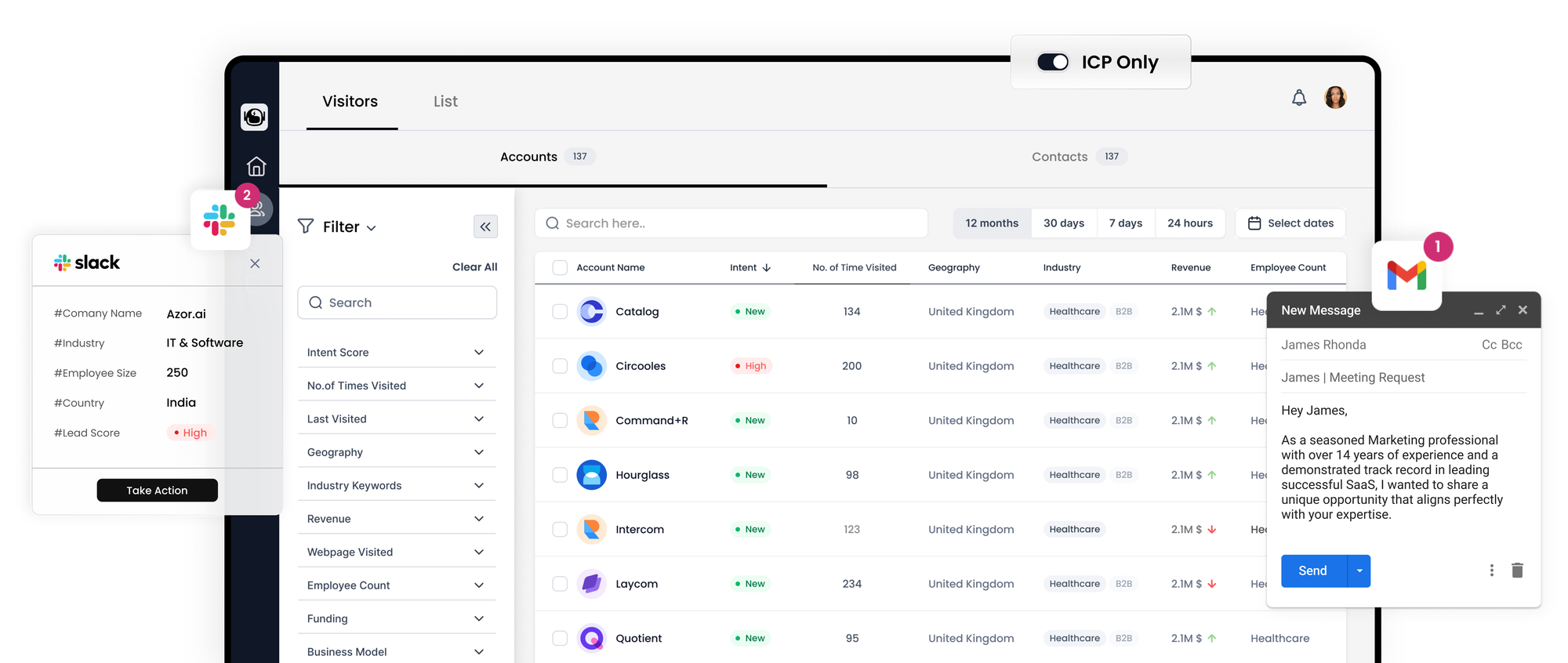Account-Based Marketing: Past, Present, and Future

When you look at the average email click-through rate of 2.6 percent, the meager 1 percent return rate on direct mail, and the less-than-1 percent conversion rate for a good social media campaign, you might wonder why these numbers are so low. The reason lies in the fact that many new marketing campaigns lack proper customer research, ideal client avatars, personalization, or segmentation. They essentially cast a wide net and hope to catch something.
In this guide, we'll delve into why account-based marketing (ABM) represents a significant opportunity, particularly for businesses seeking ideal clients who provide consistent revenue.

What Exactly Is Account-Based Marketing?
Account-based marketing is a strategic approach in B2B marketing where the sales and marketing teams collaborate to identify and target the most qualified accounts as potential customers. It essentially flips the traditional sales funnel upside down.
In the traditional approach, marketing teams use generalized marketing campaigns aimed at broad customer personas, hoping that something will resonate with a portion of the audience. It's like fishing with nets, where you're not entirely certain what you'll catch.
In contrast, ABM involves a more precise approach, akin to fishing with spears. Sales and marketing teams work together to pinpoint the specific clients they want to pursue. This collaborative effort allows the marketing team to identify ideal clients and create tailored campaigns that directly address this select audience.
Real-Life Examples of Account-Based Marketing
Account-based marketing thrives on crafting campaigns for highly specific audiences, enabling customization at an unprecedented level. Here are some practical examples of ABM in action:
1. Webinars
Imagine you're targeting an outdoor retailer specializing in custom kayaks for professional fishermen. This is a niche audience, and ABM allows you to create a webinar focused exclusively on marketing strategies for custom kayak companies.
2. Live Events
Live, in-person events are even more effective than webinars. While planning such an event, collaborate closely with the sales team to identify key prospects. You can also offer personalized upsells, such as VIP passes, VIP rooms, or exclusive merchandise, to those prospects you aim to convert.
3. Pay-Per-Click (PPC) Advertising
Platforms like Google Ads, Facebook, LinkedIn, and Instagram offer avenues to reach high-value clients through ABM. Once you've pinpointed your targets, you can craft specific campaigns tailored to these select prospects.
To draw a parallel to our earlier analogy, ABM represents a shift from casting a wide net and hoping for the best to a highly focused approach. It's about knowing precisely what you want to catch, where to find it, and how to reel it in. With ABM, the strategy is clear; all that remains is to execute it effectively.
Why and When You Should Utilize Account-Based Marketing
In the realm of marketing, we often begin with a broad-based approach to "cast a wide net" and explore various opportunities. However, as time goes on, it becomes essential to shift away from this generalized approach and focus our efforts on clients who not only recognize our worth but also commit to a long-lasting partnership. I often refer to these clients as the "ideal clients." Once you have a clear understanding of who these ideal clients are, account-based marketing (ABM) becomes a powerful tool to reach them effectively.
Here are specific scenarios where the use of account-based marketing is highly recommended:
1. Bringing Marketing and Sales into Harmony
Many organizations struggle with the misalignment of their sales and marketing teams. ABM presents an opportunity for these two departments to collaborate, share a common objective, and support each other's efforts seamlessly.
2. Boosting Engagement
A clear sign that you may be targeting the wrong audience is when you observe minimal engagement with your marketing campaigns. This could indicate audience fatigue caused by repetitive and generic marketing content. In such cases, transitioning to a personalized ABM strategy tailored to a specific audience can rekindle engagement.
3. Maximizing Return on Investment (ROI)
Both marketing and sales aim to guide prospects through the sales funnel, but the quality of leads matters as much as the quantity. Prioritizing ROI means focusing on bringing only the most qualified accounts into the funnel. This approach not only saves resources but also yields better results in the long run.
Benefits of Account-Based Marketing
Now, let's delve into the direct advantages of implementing an account-based marketing strategy compared to broader approaches:
1. Shortened Sales Cycle
By engaging directly with key decision-makers early in the process, ABM can significantly reduce the length of the sales cycle. This not only saves valuable time but also results in cost savings, ultimately maximizing ROI.
2. Personalization Saves Resources
Broad marketing efforts often involve spending time on prospects who have limited understanding of your business. In contrast, ABM attracts prospects who are already well-informed about your company and ready to make informed decisions. This personalized approach conserves both time and money in the long term.
3. Simplified ROI Measurement
Narrowing down the funnel in ABM means concentrating on a smaller pool of prospects. Consequently, tracking ROI becomes more straightforward and delivers more accurate results. For example, if you reach out to 100 ideal clients and convert 10 of them, your ABM conversion rate stands at a clear 10 percent. This contrasts favorably with reaching out to a vast audience and converting 10 individuals, only to see four of them disengage after the first month. ABM allows you to nurture well-qualified, long-term prospects who are more likely to remain committed to your brand.
How to Strategize and Initiate Account-Based Marketing
Now that we have a comprehensive understanding of account-based marketing (ABM), let's dive into practical steps to kickstart your ABM efforts:
1. Precisely Define Your Targets
Collaborate closely with your sales team to identify and define warm prospects. What characteristics distinguish them? What is their revenue potential? Where do they typically engage online? Utilize this information to craft a highly personalized marketing campaign.
2. Conduct Thorough Research
Invest time in comprehensive research. Gain insights into what motivates your prospects and develop creative ideas that make them feel like your marketing campaign was tailor-made for them – because it truly is.
3. Select Your Channels
Carefully consider where you will reach your target audience and the tools or platforms you'll employ to achieve this. Are they more likely to be a younger demographic active on platforms like Instagram and TikTok, or do they consist of older executives who prefer direct mail or attending live events? Address these questions to reach your audience effectively and maximize ROI.
4. Execute Your Campaigns and Continuously Measure
Unlike broader marketing efforts where accumulating data is typically advisable before drawing conclusions, ABM requires a different approach. With a narrow audience, you may deplete your ad budget rapidly. Therefore, closely monitor your campaigns and their effectiveness. If early signs of success are lacking, be prepared to make timely adjustments.
Strategies for Effective Account-Based Marketing Implementation
To optimize the outcomes of your account-based marketing campaigns, consider the following strategic insights:
1. Meticulously Plan Every Aspect
Given that you are targeting specific accounts, your marketing campaigns must be meticulously tailored. Critical details such as understanding competitors, nurturing customer relationships, identifying buying and selling points, and emphasizing top-selling products or services should be part of your plan.
2. Harmonize with the Sales Team
Ensure seamless alignment between all stakeholders, from the marketing president to new sales team members. Clear communication is vital, as everyone shares the common objective of securing high-value clients.
3. Establish a Dedicated Account-Based Team
As you engage with prospects before they become clients, a dedicated account management team can be invaluable. Their focus should be on cultivating relationships and comprehending the unique requirements of each account. This approach streamlines communication and minimizes the number of touchpoints needed before closing a deal.
4. Focus on a Limited Target
Avoid spreading your resources too thinly. By concentrating on two or three high-value accounts, you can tailor your campaigns to precisely address their specific needs and pain points. Overreaching too early could risk alienating your target accounts.
5. Engage Decision Makers Exclusively
Given the substantial resources invested in these select accounts, it is imperative to avoid time wastage. Focus solely on interacting with decision-makers within the organization. If you cannot target specific decision-makers, the account may not qualify as a high-value target.
6. Prioritize Warm Prospects
In addition to reaching decision-makers, collaborate with your sales team to identify prospects who exhibit warm interest. These individuals are familiar with your brand and have displayed previous interest, although they did not convert.
7. Embrace Adaptability
Continuously evaluate your campaign results, make necessary adjustments, and engage with all involved parties to explore innovative approaches. Adaptability is key to refining your ABM strategy and achieving optimal outcomes.
Frequently Asked Questions About Account-Based Marketing (ABM)
1. What Constitutes an Account-Based Marketing Platform?
An account-based marketing platform is a technological tool designed to facilitate the scalability of your marketing campaigns. These platforms empower you to conduct larger-scale campaigns targeted at narrower audiences.
2. What Is the Cost of Implementing an Account-Based Marketing Plan?
The cost of establishing an account-based marketing plan can vary significantly based on factors such as the extent of in-house efforts versus outsourcing. We offer assistance in setting up your account-based marketing strategy to ensure a well-founded start.
3. Why Is Account-Based Marketing Significantly Important?
Account-based marketing holds paramount importance as it allows you to cater to a specific, highly targeted audience. This approach maximizes your return on investment (ROI) and attracts more high-value clients. Over time, it enhances client retention rates and generally elevates your company's overall ROI.
4. How Is Account-Based Marketing Employed?
Account-based marketing finds application in various ways, but one of its most prominent uses is aligning marketing and sales teams. When these two departments collaborate seamlessly, it results in the acquisition of more high-value clients and streamlines the entire sales process, from inception to closure.
In Conclusion: Account-Based Marketing (ABM)
Account-based marketing represents a strategic choice suitable for companies of all sizes. It enables the establishment of deeper and more meaningful relationships with clients, ultimately contributing positively to your bottom line. By implementing this approach, you can attract precisely the type of clients necessary to maintain high retention rates and foster a robust client base. Collaborate closely with your sales team to identify the right accounts, create an ideal buyer persona, and select effective avenues for reaching your target audience.
